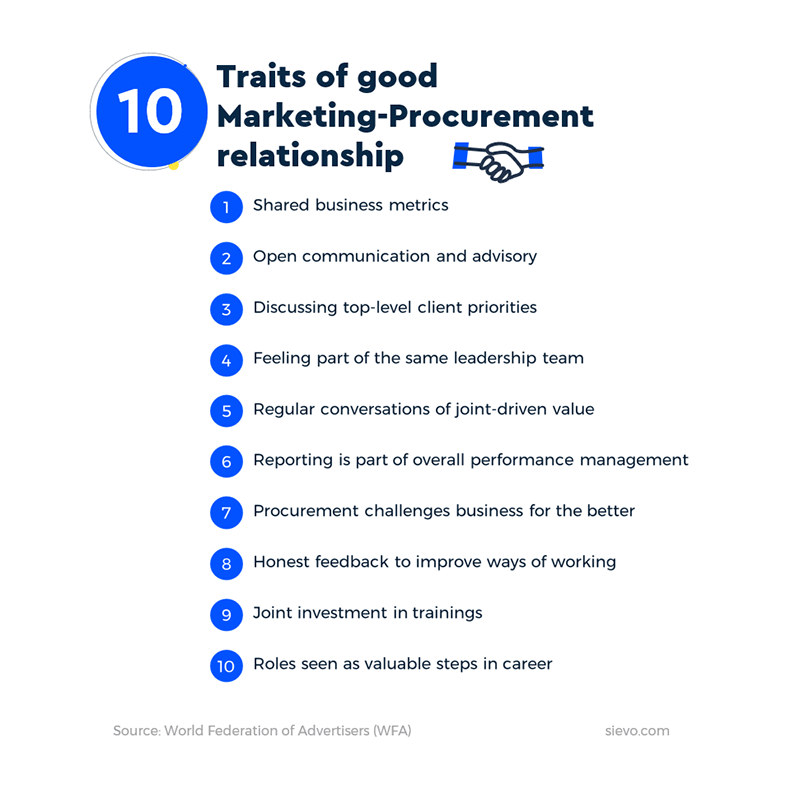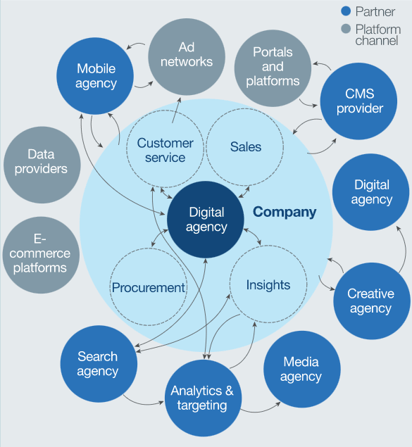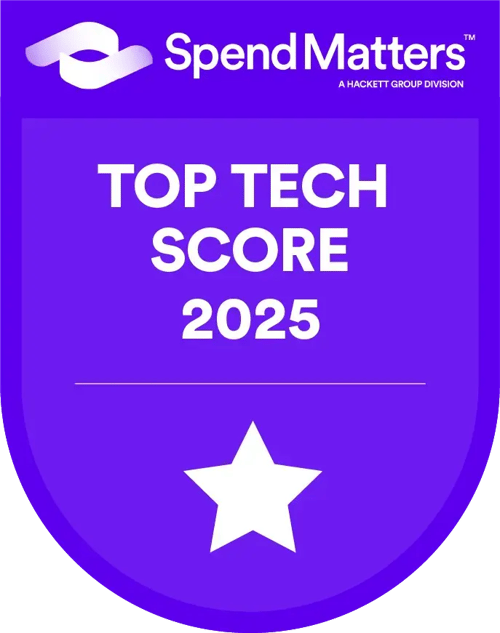The Marketing Procurement relationship: tips for collaboration
Improving the marketing-procurement relationship is more relevant than ever, as CPOs increase their strategic advisory level in businesses. Procurement needs a special set of skills to collaborate with the marketing category.
Tell Me MoreUpdated: Nov 22, 2024
One of the key issues for Procurement is to elevate its role as a strategic advisor to the business. Also, there is increasing pressure on indirect procurement categories to maintain their competitive edge with a continuously challenged budget. In some categories, cost savings may have never been in focus.
One category that can be extra difficult to manage is Marketing.
Traditionally, Procurement wants to ensure that money is spent wisely in line with corporate policies and that external relationships with suppliers are well-managed.
Marketing wants to collaborate with their partners in an agile manner and to see results with minimum interference from Procurement. Why on earth should they make purchase orders for the services when they already had a briefing session with the agency, right?
The traditional metrics used to measure procurement success, e.g. savings year-on-year, are not directly relevant when it comes to marketing value delivery.
That's why, procurement needs a special set of skills to collaborate with the marketing category.
In this article, we’ll discuss:
- An introduction to marketing spend management
- How can procurement improve marketing spend
- 10 traits of a good Marketing Procurement Relationship
- How procurement can improve marketing agency relationships
Introduction to marketing spend management
Marketing spend is regarded as indirect spend, i.e., goods and services that are not directly related to manufacturing products or core business processes.
What’s included in the marketing category differs greatly across industries. However, some core marketing services are common to most.
Examples of Marketing Category spend
Marketing spending is quite diverse. It can include:
- Strategic consultation and creative services
- Advertising and media buying
- Digital services, including social media, website development, and mobile
- Market research and benchmarking
- Branding and visual identity
- Public Relations and crisis management
- Marketing automation
- Content & search engine optimization
- Video and webinar production
- Events and promotion
- Corporate gifts and samples
- Agency fees
- Print and promotional products
- Technology tools, e.g., CRM
- Sponsorships
Traits of marketing category spend
Some of the aspects that make the marketing category unique are:
- the heavy use of agencies
- the constant change in technology and competencies
- the long planning cycles
- the emphasis on supplier relationship development
Many marketing teams work closely with one or more external agencies that account for a major share of their budget. When looking into the total cost of a campaign or a marketing project, the most cost-effective option is not always the cheapest in hourly fees.
In addition, the marketing category is in constant change. Digital technologies are changing how we do business and the types of competencies we need. Procurement needs to find a way to guide marketing through the new realities and redeem its value proposition.
Marketing planning cycles may also be longer than other functions leading to longer contract periods with fewer key suppliers. Frequent tendering may not deliver successful outcomes compared to dual-sourcing strategies and improving service level specification practices.
Supplier relationship development and performance steering are the key to successful outcomes. The conventional strategic sourcing processes don’t apply. They need to be faster and more adaptable to cater to changing market conditions, different pricing structures, and types of services required.
Typical marketing procurement spend management strategies
The traditional route to marketing spend management has been to outsource most or part of marketing activities to one full-service agency taking care of strategic and operational marketing activities.
This is becoming more difficult to achieve as the range of services to cover is so broad that one agency couldn’t specialize in all areas. If procurement suggests aggressive supplier consolidation strategies, they’re off to a bad start with marketing people.
These are the most typical strategies companies use:
- A partnership with a “full” service agency. The chosen agency may also offer a full range of support services, including engaging with sub-contractors to source media space, promotional goods, printed matter, and market research. Lead agencies can act as the coordinator, eliminating infighting among other suppliers, avoiding service overlap, and creating accountability.
- Contract with two or more service providers to deliver the range of services you need. This has the benefit of mitigating risk but requires more involvement in sourcing, negotiation, and contracting.
- A hybrid solution using a panel of providers for selected specialist services and managing other services in-house.
- A fully in-house managed marketing function - not recommended.
How can procurement improve marketing spend?
Procurement must invest considerable time in understanding marketing issues and business concerns. That means building and maintaining good internal stakeholder relationships and getting to know suppliers.
This requires patience and a genuine interest in marketing and the commercial side of the business.
Procurement can improve marketing ROI through insights into expenditure/ budgeting and improving supplier relationship management practices. Concrete areas of improvement could be service level agreements and briefing practices.
Marketing expenditure & budgeting
Despite the size or industry, managing marketing spend is no easy win. The challenge for marketing managers is to stay on top of all the different payments.
Sometimes ongoing subscriptions are forgotten, or campaign budgets run over. The end-of-year panic to spend all the leftover budget is familiar to many.
Managing spend can be overwhelming for your marketing team. But with solid spend management solutions, budgeting and forecasting will be streamlined and transparent.
Using spend analysis as a basis for your budgeting is highly recommended. This saves time and provides transparency to actual costs in the previous period. Managing big teams and budgets efficiently will be a tricky manual exercise without visibility and traceability of costs.
With real-time spend analytics in place, you won’t be surprised with a budget running out sooner than expected or having excess money to spend in December.
Supplier relationships
Procurement can work with marketing by providing benchmarks and industry intelligence on which to base supplier negotiations. Insights on spend trends, changes, and growth in marketing sub-categories can be eye-opening for marketing.
Price negotiations with agencies and others providing technical services require a different approach. Sub-contracting and the use of freelancers may incur additional margins. Negotiations around blended rate cards, media commissions, volume rebates, and other creative fee structures demand prior preparation.
Supplier relationship management (SRM) principles should be applied as per other categories. Without detailed specifications and proper briefing documentation, it’s hard to compare what was requested and what was delivered.
As a result of successful marketing-procurement collaboration, partners see systematic improvement in their relationship management and the quality of briefs while marketing is getting a better return on marketing investment.
Marketing teams must focus on rewarding and incentivizing those who deliver on target as per the terms of the agreement, applying sanctions if required. Consider what motivates the supplier. Besides monetary awards, industry awards and recognition are also great motivators!
10 Signs of a good Procurement-Marketing relationship
Now that we’ve covered what makes Marketing spend management unique and some of the ways Procurement can help, we’ll break down 10 signs of a good relationship.

The Global Sourcing Board of the WFA identify 10 traits of a successful marketing procurement team:
- Procurement and marketing have shared business metrics for success.
- Marketers are keen to receive advice and naturally call their procurement counterparts.
- Agency senior leads engage with procurement to discuss top-level client-agency priorities.
- Beyond the traditional stakeholder status: procurement and marketing feel that they are part of the same leadership team.
- Procurement leaders have regular conversations with marketing & finance on how to jointly drive value for the business.
- Reporting results is part of the over-arching business performance management and the internal and external reporting process.
- Procurement is seen as delivering business solutions and innovation by challenging and/or changing the business environment for the better.
- Marketing and procurement provide honest feedback to each other on how they can improve their ways of working.
- Marketing and procurement jointly invest in training toward working together more effectively.
- Marketers and agency partners see a role in the procurement function as a valuable step in their careers.
A strong relationship between marketing and procurement reduces marketing costs, delivering more value for the money spent.
Cost savings can be used for new campaigns and paid advertising on mutual agreement. A joint, structured approach to sourcing and contracting leads to better quality agency and other supplier relationships.
Procurement can support evaluating the success of marketing initiatives based on agreed key metrics and tracking spending.
How procurement can improve marketing agency relationships
Choosing the right agency partners is vital to any marketing organization's success. For these relationships to succeed, they should be built on a foundation of transparency and mutual respect.
Procurement professionals must be sensitive to this, knowing marketing procurement differs from other categories. Creative agencies have a significant role in establishing a brand's position in the marketplace, helping to shape customer perception of their product and service offerings.
Traditional sourcing and selection processes, without some consideration, may deliver an unsatisfactory result. Examples of this include blind tendering of creative services without enough attention to the quality of the outputs.

Image source: McKinsey -- The interconnected ecosystem of ideas and engagement between partners, agencies, and platforms.
Scope of work (SOW) in marketing
A well-designed SOW forms the basis for any sourcing activity. It defines the deliverables to be included within a supply agreement that will align expectations between the parties.
SOW is a basis for billing and the most important appendix to your agency agreement. Having a complete and clear SOW before engaging in a relationship reduces potential misunderstandings and conflicts.
But circumstances do change, and new business priorities will emerge. An SOW becomes a living document, needing regular realignment. Over time additional tasks may be added (scope creep), but work that is no longer needed may still continue at unnecessary cost.
Marketing agency supplier selection
Any organization with an existing lead marketing agency may be dissatisfied with the incumbent and feel the need to challenge it, or they may require a completely new approach and set of competencies.
It is rarely about cost. The usual process for sourcing agency services has changed little for years.
Here are some tips to apply in your marketing acency supplier tendering:
- Research the supply market for potential partners
- Define the scope, objectives, and key requirements with your team of marketers
- Approach the market with a Request for Proposal (RFP)
- Use the RFP to shortlist the candidates
- Brief each short-listed company with a request for a pitch to be delivered within 4 weeks
- Prepare a more specific set of questions or an assignment to test the candidates in practice
- Select the best fit partner, negotiate contractual terms
- Define and confirm SOW and service level agreement (SLA)
- Award the business and ensure successful contract handover
For procurement to add value to marketing procurement, they need to apply a robust process while considering the importance of relationships.
Agency pitches may promise to deliver value based on price and capability, but can they deliver? Procurement can support specification-building systematic processes and safeguards.
Applying a market benchmarking process every now and then keeps agency partners honest about rates and gives marketing leaders a chance to learn about the latest developments in the industry.
Marketing agency remuneration models
Agency compensation models can vary. This is complicating life for procurement professionals.
Retainers, fixed project fees, or hourly fees are preferred as they are easier to budget and manage.
There are complex value-based models where the agency earns a profit based on the value of its strategy or creative thinking. These are in limited use because they are both high maintenance and difficult to measure and verify. Commission-based models have the same challenges.
More widely used are rate-based structures that are used extensively in professional services such as accounting or consulting. Here the agency charges its time for a set price or hourly rate. For the client, this model secures transparency and insight into the agency’s overhead and profit.
A popular choice is a fixed retainer based on the entire SOW or a percentage of the client’s overall budget.
Pricing per project is another way to agree on costs. The agency prices the project based on the estimated hours to complete it, plus a buffer fee or margin. The client knows exactly how much it will cost and when and any budget variance must be agreed upon in advance or will be covered by the agency.
Understanding market pricing for similar services provides transparency and offers opportunities to negotiate better rates.
Agency collaboration: best practices
Open and clear communication between the parties is essential to long-term relationship success. Parties must agree on communication practices, including briefing, changes, and approvals.
- Briefing can make or break it - Using a standard briefing template across multiple projects and assignments builds consistency.
- Commit to succeed – Parties should agree on success measures for the relationship in general and every project and campaign.
- Establish steering practices – Assign a steering team for the relationship. Having a single point of contact, i.e., a key account manager, reduces the risk of errors when managing a team of experts and multiple overlapping projects.
- Speak out - The client should remember that clear communication is built on shared hopes and expectations and the guts to express your concerns.
- Set up a clear approval process – Complex approval delays the process. Define and communicate who is responsible for approvals and what is considered approval.
- Trust your partner - Agency can build trust by sharing their references, standard practices, and project plan with the client before the actual work starts.
Struggling with Excel, PowerBI, and in-house reporting?
In this essential guide, we delve into the intricacies of procurement analytics, providing a clear comparison between in-house solutions and specialized BoB software like Sievo.


